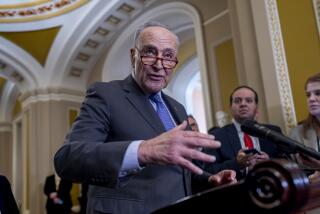Conferees Agree on $3.9-Billion in Drought Aid
- Share via
WASHINGTON — Congressional conferees completed work Thursday night on a $3.9-billion drought relief package and sent it to the House and Senate for action next week.
Presidential acceptance of the bill, which would be financed with savings from reduced federal crop subsidies, seemed certain after the conferees dropped a number of costly and controversial provisions opposed by the Administration.
Peter C. Myers, deputy secretary of agriculture, said he agreed with House and Senate Agriculture Committee calculations indicating that cost of the measure would be below budget requirements, and thus would not trigger spending cuts under the Gramm-Rudman deficit reduction act.
“We’ll recommend that the President sign it,” Myers said. He also said the likely enactment of the measure before Congress recesses next week will give the Agriculture Department a month’s edge in preparing to oversee the largest farm disaster aid program ever adopted.
Payments for Crop Loss
The legislation would assure disaster payments to farmers who lose more than 35% of a crop in what is one of the worst droughts of the century. It would also provide feed assistance to livestock producers who suffer crop losses.
Most legislators agreed that speedy action on the package, which has moved through Congress in less than a month, was induced by the expectation of the loss of more than a quarter of the American grain crop and by the approaching Nov. 8 general election.
House Agriculture Committee Chairman E. (Kika) de la Garza (D-Tex.) and his counterpart, Sen. Patrick J. Leahy (D-Vt.), said the bill would get relief quickly to drought victims who need it most.
“Our action today signals America’s farmers and ranchers that this Congress--and all Americans--will help them through these devastating times,” Leahy said.
Cost Item Dropped
The Administration’s chief objection, a $2-billion item, was erased when Senate conferees agreed to drop a provision of their bill that would have given federal feed assistance to any producer of livestock, from cattle to catfish.
The final version would send aid only to livestock producers who grow their own feed. House members and Secretary of Agriculture Richard E. Lyng argued that the relief bill was intended to help drought-affected crop farmers, not livestock producers whose higher feed costs would later be passed on to consumers.
But on other less expensive, yet contentious, issues, the conferees disregarded Administration objections. The most vivid example was a decision to raise the dairy price support for three months next year, at an estimated cost of $185 million, to help dairy farmers deal with higher feed costs.
Bars Support Cut
The support would be increased by 50 cents per hundredweight of milk, from $10.60, between next April and June. The bill also would bar a 50-cent cut in the support that was expected on Jan. 1 because of high surplus production.
Bitter debate that had been expected failed to materialize when the Senate conferees, with only Leahy voting, accepted the three-month extension contained in the House bill. The dairy lobby had sought the higher price as a way of compensating dairies for higher feed prices and to send a “signal” of support from Washington to keep milk production steady.
More to Read
Get the L.A. Times Politics newsletter
Deeply reported insights into legislation, politics and policy from Sacramento, Washington and beyond. In your inbox twice per week.
You may occasionally receive promotional content from the Los Angeles Times.










